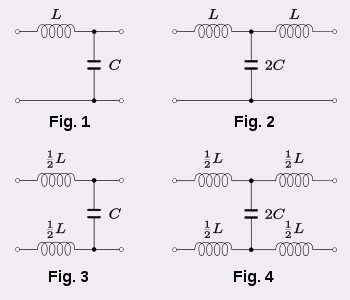|
A balanced circuit will normally show a symmetry of its components about a
horizontal line midway between the two conductors (example in figure 3). This
is different from what is normally meant by a symmetrical circuit, which is a
circuit showing symmetry of its components about a vertical line at its
midpoint. An example of a symmetrical circuit is shown in figure 2. Circuits
designed for use with balanced lines will often be designed to be both balanced
and symmetrical as shown in figure 4. The advantages of symmetry are that the
same impedance is presented at both ports and that the circuit has the same
effect on signals travelling in both directions on the line.
Balance and symmetry are usually associated with reflected horizontal and
vertical physical symmetry respectively as shown in figures 1 to 4. However,
physical symmetry is not a necessary requirement for these conditions. It is
only necessary that the electrical impedances are symmetrical. It is possible to
design circuits that are not physically symmetrical but which have equivalent
impedances which are symmetrical.
|

Example of 4 different circuit configurations,
using a low-pass filter, to demonstrate.
Fig. 1. Unbalanced, asymmetrical circuit.
Fig. 2. Unbalanced, symmetrical circuit.
Fig. 3. Balanced, asymmetrical circuit.
Fig. 4. Balanced, symmetrical circuit.
|
